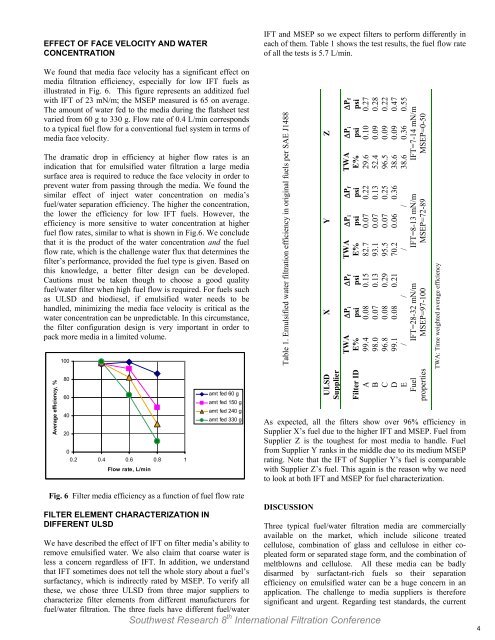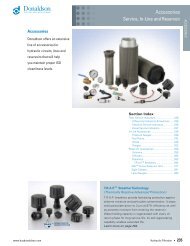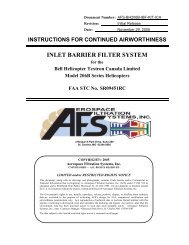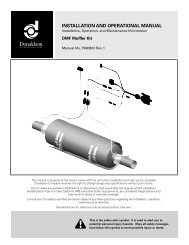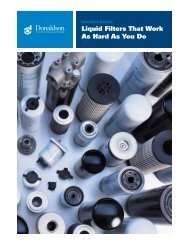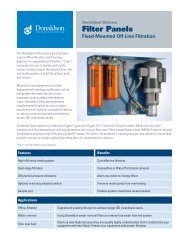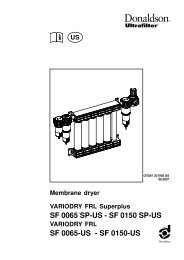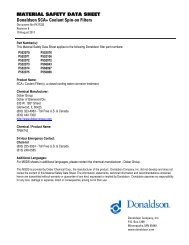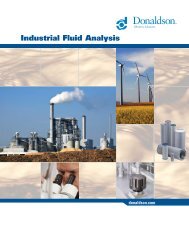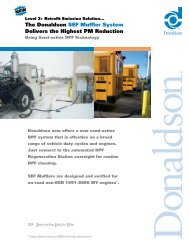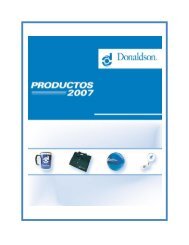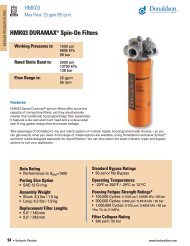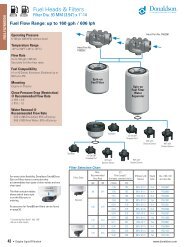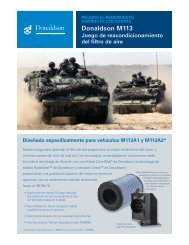Understanding Emulsified Water Filtration - Donaldson Company, Inc.
Understanding Emulsified Water Filtration - Donaldson Company, Inc.
Understanding Emulsified Water Filtration - Donaldson Company, Inc.
Create successful ePaper yourself
Turn your PDF publications into a flip-book with our unique Google optimized e-Paper software.
EFFECT OF FACE VELOCITY AND WATER<br />
CONCENTRATION<br />
We found that media face velocity has a significant effect on<br />
media filtration efficiency, especially for low IFT fuels as<br />
illustrated in Fig. 6. This figure represents an additized fuel<br />
with IFT of 23 mN/m; the MSEP measured is 65 on average.<br />
The amount of water fed to the media during the flatsheet test<br />
varied from 60 g to 330 g. Flow rate of 0.4 L/min corresponds<br />
to a typical fuel flow for a conventional fuel system in terms of<br />
media face velocity.<br />
The dramatic drop in efficiency at higher flow rates is an<br />
indication that for emulsified water filtration a large media<br />
surface area is required to reduce the face velocity in order to<br />
prevent water from passing through the media. We found the<br />
similar effect of inject water concentration on media’s<br />
fuel/water separation efficiency. The higher the concentration,<br />
the lower the efficiency for low IFT fuels. However, the<br />
efficiency is more sensitive to water concentration at higher<br />
fuel flow rates, similar to what is shown in Fig.6. We conclude<br />
that it is the product of the water concentration and the fuel<br />
flow rate, which is the challenge water flux that determines the<br />
filter’s performance, provided the fuel type is given. Based on<br />
this knowledge, a better filter design can be developed.<br />
Cautions must be taken though to choose a good quality<br />
fuel/water filter when high fuel flow is required. For fuels such<br />
as ULSD and biodiesel, if emulsified water needs to be<br />
handled, minimizing the media face velocity is critical as the<br />
water concentration can be unpredictable. In this circumstance,<br />
the filter configuration design is very important in order to<br />
pack more media in a limited volume.<br />
Average efficiency, %<br />
100<br />
80<br />
60<br />
40<br />
20<br />
0<br />
0.2 0.4 0.6 0.8 1<br />
Flow rate, L/min<br />
amt fed 60 g<br />
amt fed 150 g<br />
amt fed 240 g<br />
amt fed 330 g<br />
Fig. 6 Filter media efficiency as a function of fuel flow rate<br />
FILTER ELEMENT CHARACTERIZATION IN<br />
DIFFERENT ULSD<br />
We have described the effect of IFT on filter media’s ability to<br />
remove emulsified water. We also claim that coarse water is<br />
less a concern regardless of IFT. In addition, we understand<br />
that IFT sometimes does not tell the whole story about a fuel’s<br />
surfactancy, which is indirectly rated by MSEP. To verify all<br />
these, we chose three ULSD from three major suppliers to<br />
characterize filter elements from different manufacturers for<br />
fuel/water filtration. The three fuels have different fuel/water<br />
IFT and MSEP so we expect filters to perform differently in<br />
each of them. Table 1 shows the test results, the fuel flow rate<br />
of all the tests is 5.7 L/min.<br />
As expected, all the filters show over 96% efficiency in<br />
Supplier X’s fuel due to the higher IFT and MSEP. Fuel from<br />
Supplier Z is the toughest for most media to handle. Fuel<br />
from Supplier Y ranks in the middle due to its medium MSEP<br />
rating. Note that the IFT of Supplier Y’s fuel is comparable<br />
with Supplier Z’s fuel. This again is the reason why we need<br />
to look at both IFT and MSEP for fuel characterization.<br />
DISCUSSION<br />
Three typical fuel/water filtration media are commercially<br />
available on the market, which include silicone treated<br />
cellulose, combination of glass and cellulose in either copleated<br />
form or separated stage form, and the combination of<br />
meltblowns and cellulose. All these media can be badly<br />
disarmed by surfactant-rich fuels so their separation<br />
efficiency on emulsified water can be a huge concern in an<br />
application. The challenge to media suppliers is therefore<br />
significant and urgent. Regarding test standards, the current<br />
Southwest Research 8 th International <strong>Filtration</strong> Conference<br />
Table 1. <strong>Emulsified</strong> water filtration efficiency in original fuels per SAE J1488<br />
X Y Z<br />
ULSD<br />
Supplier<br />
TWA ΔPi ΔPf TWA ΔPi ΔPf TWA ΔPi ΔPf<br />
Filter ID E% psi psi E% psi psi E% psi psi<br />
A 99.4 0.08 0.15 82.7 0.07 0.22 29.6 0.10 0.27<br />
B 98.0 0.07 0.13 93.1 0.07 0.13 52.4 0.09 0.28<br />
C 96.8 0.08 0.29 95.5 0.07 0.25 96.5 0.09 0.22<br />
D 99.1 0.08 0.21 70.2 0.06 0.36 38.6 0.09 0.47<br />
E / / / / 38.6 0.36 0.55<br />
Fuel IFT=28-32 mN/m IFT=8-13 mN/m IFT=7-14 mN/m<br />
properties MSEP=97-100<br />
MSEP=72-89<br />
MSEP=0-50<br />
TWA: Time weighted average efficiency<br />
4


